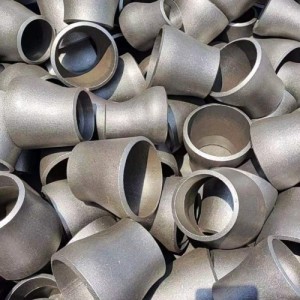Reducer
-

How To Use Eccentric Reducer
To use an eccentric reducer, follow these steps:
Measure the pipe sizes: Determine the size of the larger and smaller pipes that you need to connect using the eccentric reducer.
Select the appropriate eccentric reducer: Choose an eccentric reducer that matches the size of the larger and smaller pipes.
Ensure that the eccentric reducer is made of a suitable material for the specific application, such as stainless steel, carbon steel, or PVC.
Prepare the pipes: Cut the larger and smaller pipes to the desired length, ensuring that the ends are clean and free from any debris or burrs.
Install the eccentric reducer: Slide the eccentric reducer onto the larger pipe, ensuring that the flat side of the reducer is aligned with the top of the pipe.
The offset portion of the reducer should be positioned to allow for the desired flow direction.
Connect the pipes: Insert the smaller pipe into the offset end of the eccentric reducer, ensuring a secure and tight fit.
Use appropriate fittings and fasteners to secure the connection if necessary.
Test the connection: Once the pipes are connected, perform a pressure test to ensure that the connection is secure and leak-free.
-

ASME B16.9 Carbon Black Stainless Steel Connector Eccentric Butt Weld Pipe Fitting Reducer
Reducer Type Seamless reducer; Welded reducer;
Concentric reducer; Eccentric reducer;
butt welding reducer; forged reducer;
forging reducer; welding reducer;Size OD. 1/2” ~ 48”(Seamless); 16” ~96”(welded); DN15-DN1200 WTK. Sch10SCH20,SCH30,STD,SCH40,SCH60,XS,SCH80,SCH100,SCH120,SCH140,SCH160, XXS Standard ASME B16.9-2007
ANSI/ASME B16.11
ASME B16.25-2007
ASME B16.5-2007
EN10253-1-1999 EN10253-2-2007 EN10253-3-2008 EN10253-4-2008
DIN2605-1-1992 DIN2605-2-1995
JIS B2311-2009 JIS B2312-2009 JIS B2313-2009
GB/T12459-2005 GB/T13401-2005 GB/T10752-2005
SH/T3408-1996 SH/T3409-1996
SY/T0609-2006 SY/T0518-2002 SY/T0510-1998
DL/T695-1999 GD2000 GD87-1101
HG/T21635-1987 HG/T21631-1990 ,
MSS SP-43, MSS SP-95, MSS SP-75, MSS SP-79;
ISO 3419,ISO 5251,DIN 2616Material Carbon steel ASTM A234 WPB,
ASTM A420 WPL6, WPL3;
ASTM A105 WPB;
ASTM A106;
ASTM A350 LF2,
DIN St37, St45.8, St52.4,St.35.8,St.35.8
ASTM A333 GR.6,
ASTM A860 WPHY 70, WPHY 65, WPHY 60, WPHY 52,WPHY 46,WPHY 42,
API 5L GRB, X60, X65, X42,X52,Stainless steel ASTM A403 WP304, A403 WP304L, A403 WP316, A403 WP316L, A403 WP321
ASTM A182 F 304, 304L,316, 316L,904LAlloy steel ASTM A234 WP12, A234 WP11, A234 WP22, A234 WP5, A234 WP9
A420 WPL8, A420 WPL9
ASTM A335 P5, P9, P11, P12, P22, P91
ASTM A213
ASTM A182 F5,F11,F22,F91Surface Black painting, varnish paint, anti rust oil, hot galvanized, cold galvanized, 3PE, etc. Manufacturing process Push, Press, Forge, Cast, etc. Connection welding Technical Welded, forged MOQ 10 pieces Packing Wooden cases, pallets, nylon bags or according to the customers’ requirements Delivery time 7-35 days after your advance payment Payment terms L/C, T/T, D/A, etc. Shipment FOB Tianjin, CIF, CFR, etc Remarks Other materials and drawings are available. Capacity 1000000tons/year Advantages 1. Reasonable price with excellent quality 2. Abundant stock and prompt delivery 3. Rich supply and export experience, sincere service 4. Reliable forwarder, 2-hour away from port. Main clients Turkey, Italy, France, Spain, South Africa, Mexico, Dubai, Iran, Syria, Singapore, Vietnam,
Austria, USA, Canada, Mexico, Korea, Thailand, India, Bulgaria, Russia and so on -

Concentric Reducer
Size: 1/2″-24″
Thickness:SCH5-SCH160
End: Beveling
Surface : Sand Blasting
-

A234WPB Eccentric Reducer 8*6
Product Name: Carbon Steel Eccentric Reducer
Size :1/2″-24″
Thickness: SCH5-SCH160
Ends: Beveling
Surface: Black Painting and Sand Blasting
-

Butt Weld Pipe Fitting Stainless Steel SS304 Concentric Reducer SCH10
Product Name: Stainless Steel Pipe Fititng
Size: 1/2″-24″
Thickness : SCH5-SCH160
End: Beveling
Surface : Sand Blasting
-

Carbon Steel Concentric Reducer SCH STD 6″*4“
Product Name: Carbon Steel Concentric Reducer
Size: 1/2″-24″
Thickness: SCH5-SCH XXS
Ends: Beveling
Surface: Black Painting and Sand Blasting
-

Steel Pipe Reducer
Product Name: Steel Pipe Reducer
Size: 1/2″-24“
Thickness: SCH5-SCH160
Material: Carbon Steel Stainless Steel Alloy Steel
Ends: Beveling
Surface: as customers’ requirement
-

Pipe Reducer 6″*4″ SCH40 ASME B16.9 A234WPB
Product Name: Pipe Reducer
Size: 6″*4″
Thickness: SCH40
Material: A234WPB
Standard: ASMB B16.9
-

High Quality 304/316 Steel Pipe Fittings Concentric/Eccentric Reducer
A pipe reducer is a type of pipe fitting used to connect two pipes of different diameters, facilitating a smooth transition in flow diameter within a piping system. Reducers are essential in various industrial, commercial, and residential piping applications to ensure efficient fluid (liquid or gas) transfer while maintaining system integrity. Types of Pipe Reducers Concentric Reducer Shape: Cone-shaped with a symmetrical gradual reduction. Use: Used in vertical pipelines where air or gas p... -

Pipe Reducer
A pipe reducer is a fitting used to connect pipes of different diameters. Its primary function is to achieve a reduced diameter connection within a piping system. It can smoothly change the flow rate and pressure of the medium within the pipe, ensuring smooth operation of the piping system. Main Types 1. Concentric Reducer Conical shape with a consistent centerline Used for vertical pipes or where top/bottom flushing is required Reduces cavitation and turbulence 2. Eccentric Reducer One... -

ASME B16.9 Carbon Black Stainless Steel ASME A403 Wp 304 ASME A403 Wp 316 Concentric Seamless Connector Eccentric Butt Weld Welding Pipe Fitting Reducer
Reducer Type:
Seamless reducer;
Welded reducer;
Concentric reducer;
Eccentric reducer;
Butt welding reducer;
Forged reducer;
Forging reducer;
Welding reducer;
